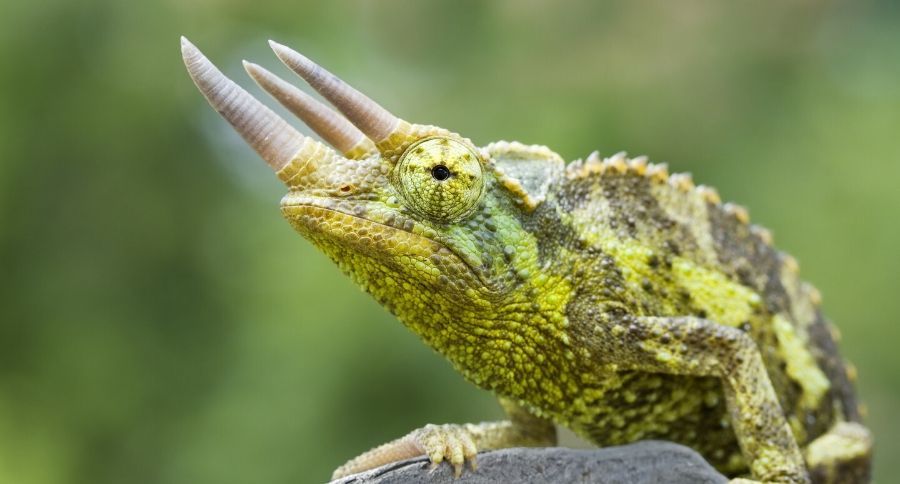Jackson's chameleons are pets better suited to being watched than handled! They are like little triceratops.
This is a reptile that is not for novice pet owners. Experts at Chicago Exotics Animal Hospital tell us that these Jackson's chameleons have become increasingly popular pets due to their beautiful green coloration and the male's three horn-like appendages on the face. Yet they don't tolerate handling well.
"Typically, chameleons are an observation only pet and typically tolerate handling poorly. Jackson's chameleons are frequently given up due to their extensive husbandry requirements. These lizards can be a hefty financial investment and an investment of time as well."
Breed overview
- Adults may reach 12-15 in in total (snout to tail) length, with a body length of about 5 in.
- Adults can reach 0.9-1.8 kg but most weigh less.
- Their life span is 3-8+ years.
- Young Jackson's chameleons are brownish, developing brighter green coloration at about four or five months of age.
- Males tend to be more brightly colored, with blue or yellow markings.
They're sometimes called three-horned chameleons because the males of the species have small brown horns above their eyes and one on the nose!
Behavior and temperament
https://www.instagram.com/p/B8uIf7qiDZP/
This is where you need to be careful. They really don't enjoy being handled.
According to The Spruce's Pets, Jackson's chameleons are territorial and should be housed individually. Handling is stressful to them, so as with other chameleons, they are pets better suited to being watched than handled.
Habitat and environment
An adult chameleon needs space to roam and an enclosure with screen sides is best.
The minimum recommended cage is 24 inches long by 24 inches wide and 36 inches tall to allow for a full range of vertical movements. An enclosure with a locking mechanism is strongly recommended. Make sure to have branches and live non-toxic plants.
Feeding and diet
https://www.instagram.com/p/B8nP9oqDTmT/
These three-horned chameleons have very specific diets. Lafeber Vet tells us that they need variety.
- Feed a variety of gut-loaded insects such as crickets, mealworms, grasshoppers, roaches, super worms, silkworms, and wax worms as well as pesticide-free snails, slugs, caterpillars, sowbugs, spiders, and flies of appropriate size.
- Dust the adult non-breeding diet with calcium carbonate or calcium gluconate supplement once weekly.
- Calcium supplements should be devoid or low in phosphorus with a minimum Ca:P ratio of 2:1. Avoid products containing high levels of Vitamin D as this can lead to toxicity.
How to choose
Look for a reputable breeder and a reptile or exotics veterinarian. Chameleons should have alert eyes, without any cloudiness. If they look ill to you then choose another chameleon!
A little history?
Jackson's chameleons are found primarily in Kenya where they are protected from collection and Tanzania in limited areas. Introduction into Hawaii has resulted in an invasive species of lizard that is thriving much like the Veiled chameleons.
Jackson's chameleons were not discovered by a scientist named Jackson; rather their name comes from an ornithologist and prior governor of Kenya, Frederick Jackson.
Other fun facts?
- Some chameleon species, including Jackson's chameleon, have "chromatophores" or specialized cells in the skin that allow color change.
- When considering the environment, a basking light can be provided using a reptile heat lamp, spotlight or ceramic heat emitter. The basking spot will be around 85-90 F but care should be taken to make sure your pet can not access the bulb or the lamp.
- Along with heat lamps and regular daylights, a UVB light should be supplied. These bulbs give off UVB rays which help the chameleon to synthesize vitamin D into D3. This is the active form of vitamin D which is necessary for calcium metabolism. Without these bulbs, your chameleon may succumb to abnormal behaviors, metabolic bone disease, and fractured legs.
If you're researching these reptiles, you should consider their scientific name Chamaeleo jacksonii.
Do you live with a chameleon? What essentials did we miss? Please leave us a comment below!




